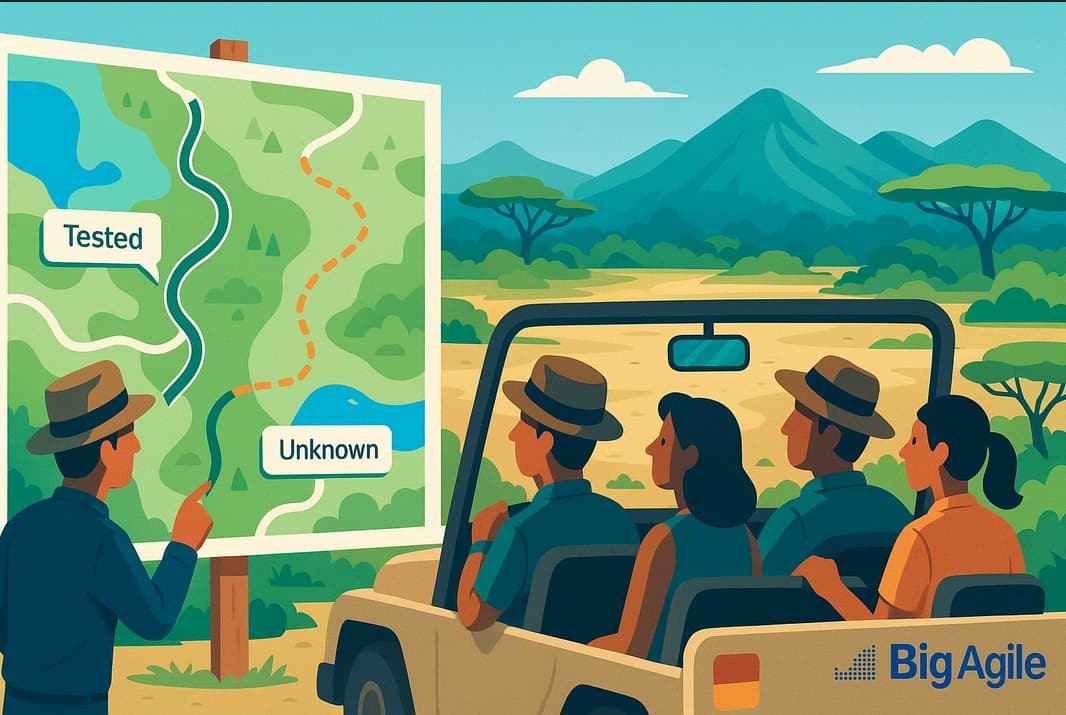
Let's think about this for a second...Do you really need to choose a scaling framework?
The moment your teams outgrow a single Sprint Review, the search term “SAFe vs LeSS vs Scrum@Scale” lights up Google Trends; let’s untangle the options so you can scale with purpose, not pain.
Why Do We Need a Scaling Framework at All?
Agile It was born on small, cross‑functional teams. Yet many enterprises struggle with hundreds of developers, inflexible funding models, and compliance gates. Frameworks like SAFe (Scaled Agile Framework), LeSS (Large-Scale Scrum), and Scrum@Scale aim to maintain Scrum’s empirical core while acknowledging the realities of large companies. Each provides guardrails, governance, and vocabulary to coordinate dozens, if not thousands, of people without stifling adaptability.
Snapshot Comparison
| Framework | Tagline / Purpose | Typical Org Size | Governance Style | Primary Trade‑offs |
|---|---|---|---|---|
| SAFe | “Synchronize strategy to execution” | 125–10,000+ | Defined roles, layered ceremonies, explicit portfolio controls | High alignment; risk of heavyweight process |
| LeSS | “Scrum principles appliedlarger” | 50–500 | Minimal roles, two‑level structure, feature teams | Leanest overhead; assumes disciplined teams |
| Scrum@Scale | “Scale the minimum viable bureaucracy” | 25–2,000 | Fractal networks of Scrum Masters & POs, modular add‑ons | Modular; can feel abstract without coaching |
Deep Dive: Strengths, Limits, and Best‑Fit Contexts
1. SAFe – Enterprise Alignment, Clear Rails
- Inventor: Dean Leffingwell
- Strengths: built‑in portfolio funding model; synchronized Program Increment (PI) planning; comprehensive guidance for compliance, DevOps, and hardware integration.
- Watch‑outs: ceremony overload if adopted “by the book”; can reinforce siloed component teams; agility may stall if leadership treats PI plans as contracts.
- Best for: heavily regulated industries, multi‑vendor programs, or organizations where execs demand line‑of‑sight from budget to feature roadmaps.
2. LeSS – Scale by Reducing Complexity
- Inventors: Craig Larman, Bas Vodde
- Strengths: emphasizes feature teams, systems thinking, and ruthless elimination of hand‑offs; only two additional roles (Area Product Owner in LeSS Huge, if needed).
- Watch‑outs: cultural shock for organizations addicted to hierarchy; requires disciplined technical practices (CI/CD, test automation) to avoid quality bottlenecks.
- Best for: companies ready to reorganise into customer‑oriented, cross‑functional feature teams and willing to confront systemic impediments head‑on.
3. Scrum@Scale – Decentralize, Then Recombine
- Inventor: Dr. Jeff Sutherland
- Strengths: modular “what to add, when” approach; Executive MetaScrum links strategy to delivery without heavyweight committees; scales up or down gracefully.
- Watch‑outs: blueprint is abstract; success hinges on experienced Scrum Masters who can architect the network of teams and coach leaders on servant leadership.
- Best for: organizations that value flexibility, already practicing solid team‑level Scrum, and prefer incremental change over a big‑bang reorg.
Decision Guide: Five Questions to Narrow Your Choice
- How much organisational redesign can you stomach? If minimal, lean toward SAFe; if transformative, LeSS or Scrum@Scale.
- Are your teams already cross‑functional? LeSS assumes “yes”. SAFe and Scrum@Scale tolerate gradual evolution.
- What level of executive sponsorship exists? All three need it, but SAFe provides the clearest executive playbook.
- Regulatory or hardware constraints? SAFe’s guidance is prescriptive; LeSS and Scrum@Scale leave practices to teams.
- Coach availability? Scaling agility without seasoned enterprise coaches courts trouble; budget for expertise regardless of framework.
Frequently Asked Questions
Q: Is SAFe anti‑Agile? No; it embeds Lean and Agile principles, but poor implementations can feel waterfall‑lite. Focus on outcomes, not rituals.
Q: Do I need to pick one framework forever? No; many organizations start with SAFe for governance, then slim down to Scrum@Scale or LeSS as capability matures.
Q: Can we blend elements? Possibly, but accidental franken‑frameworks risk confusion; understand underlying principles before mixing.
Q: How long until we see benefits? 3–6 months to stabilize ceremonies, 12+ months for cultural shifts; metrics must look beyond velocity.
Next Steps: Turn Framework Choice into Genuine Business Agility
Selecting a framework is step one. Sustaining it requires:
- Leadership agility training so executives model empowered decision‑making.
- Technical excellence; CI/CD, automated testing, and DevSecOps underpin any scaling effort.
- Outcome‑based metrics; measure lead time, customer value, and flow efficiency, not story points alone.
Remember, the framework is a tool, not a ritual. Use it to get better and you should be SAFe (LOL).